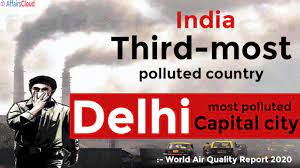World Air Quality Report 2020 India Rank: According to the World Air Quality Report released by IQ Air (Swiss Air Technology Company), Delhi is the most polluted Capital city Globally for the 3rd Consecutive time followed by Dhaka(Bangladesh) and Ulaan Baatar(Mongolia). World Air Quality Report 2020 India Rank is given below in this article. In the case of the world’s most polluted cities, Hotan of China came first followed by India’s Ghaziabad (Uttar Pradesh) and Bulandshahr (Uttar Pradesh). The rankings are based on the Annual average PM 2.5 (Particulate Matter) of the year 2020. It covered 106 countries.
For Latest Current Affairs Updates Click Here
World Air Quality Report 2020 India Rank is 3rd Most Polluted Country across the world. According to the report, South and East Asian countries continue to be the most polluted locations in the world. 37 out of 40 most polluted cities in 2020 are in South Asia. World Air Quality Report 2020 India Rank and the cities in India with major pollution are given below. Air Pollution causes a loss of 7.4% of South Asia’s GDP.
Page Contents
World Air Quality Report 2020 Global Scenario:
- India is the third most polluted country in 2020, unlike in 2019 when its air was the fifth most noxious.
- Bangladesh and Pakistan were the countries in 2020 with worse average PM2.5 levels than India, said the report.
- China ranked 11th in the latest report.
- of the 106 monitored countries, only 24 met the World Health Organization annual guidelines for PM 2.5.
World Air Quality Report 2020 India Rank: Delhi the Most Polluted Capital City
- Delhi remained the most polluted Capital City in the World but India, on the whole, had improved its average annual PM 2.5 (particulate matter) levels higher in 2020 than in 2019, according to a report from IQ Air, a Swiss air quality technology company, specializing in protection against airborne pollutants, and developing air quality monitoring and air cleaning products.
- Average pollution levels were 51.9 µg/m³ in 2020 compared with 58.1 µg/m³ in 2019, making India only the third most polluted country in 2020, unlike in 2019, when its air was the fifth most noxious.
World Air Quality Report 2020 India Rank:
| Rank | Country | PM |
| 3 | India | 51.9 |
| 2 | Pakistan | 59.0 |
| 1 | Bangladesh | 77.1 |
- India was home to 35 of the World’s 50 most polluted cities.
- Compared to 2019 levels, India recorded an 11% reduction in the annual average of PM2.5 levels due to coronavirus lockdown.
- Major Sources of India’s Air pollution – Transportation, Stubble Burning, Construction.
World Air Quality Report 2020: Reasons for Air Pollution in India
- In the urban areas, most of the pollution comes from industry and vehicles, whereas in the rural areas, most comes from the burning of organic material.
- This material is used as a fuel for the domestic stoves, and also in the heaters needed to keep the houses warm in the colder months.
- During autumn and winter, huge amounts of stubble are burnt in the fields as a way of preparing the ground for the next crop.
- This method is much cheaper than the alternative option of plowing the residue back into the land.
- This can be particularly bad as garbage is often thrown into the fires by way of disposal.
This combines with other pollutants to rank India as the world’s third greatest producer of greenhouse gases, behind China and the USA. The Air (Prevention and Control of Pollution) Act was inaugurated in the early ‘80s but has failed to make an impact due to the poor enforcement of the rules.
Can India’s air quality be improved?
- At the beginning of 2019, the Indian government inaugurated the National Clean Air Program (NCAP) to address the situation.
- It is their aim to reduce levels of air pollution by 20-30 percent by 2024 in over 122 of the worst affected cities.
- Actions being taken in New Delhi, Ahmedabad and Pune include the implementation of health risk communications plans, the increase in the number of monitoring stations, and better control of industrial emissions.
“The year 2020 brought an unexpected dip in air pollution. In 2021, we will likely see an increase in air pollution due to human activity, again,” said Frank Hammes, CEO of IQAir.
“We hope this report will highlight that urgent action is both possible and necessary to combat air pollution, which remains the world’s greatest environmental health threat.”






